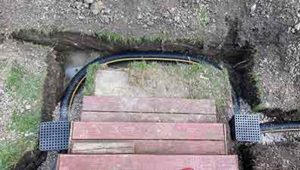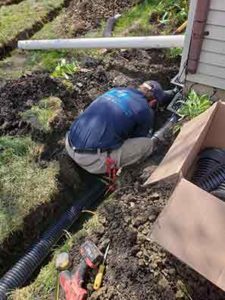The first time you hear the term “drain tile”, your inclination might be to think of the tiles on the floor of your home. But drain tiles have nothing to do with your home’s flooring. They are perforated pipes surrounded by stones that are used to keep groundwater from getting into your home’s basement.
Understanding drain tile systems
Originally, drain pipes were made from sections of clay. Hence, being called tiles instead of pipes. Today, however, most drain pipes are made of PVC or plastic. They consist of sections of perforated pipes laid inside a gravel trench and overlaid with more gravel.
The gravel allows groundwater to collect in the trench and find its way into the pipes through the holes on the sides of the pipes. The water is subsequently transported away from the house. Sometimes drain tiles are covered with sleeves to keep dirt from getting into them.
Drain tiles are essential for keeping the house safe in the event of heavy rain or rapid snowmelt. They can be installed on the outside of the home’s foundation or around the inside of the foundation.
If installed as part of the original construction – that is, when the house was built – drain tiles are typically buried in the ground outside the foundation. Regardless of when it was installed, all drain tiles operate on a simple principle: to create a path of least resistance for water to follow, away from the home.
Water collected by the pipes in a drain tile system is disposed of in two ways:
- If the home is built on land with a sufficiently steep slope, the usual solution is to let the water run downhill under the force of gravity and release it at some exit point. This is similar to how drain tiles were used when the idea was first conceived as a way to remove water from poorly drained farmland.
- The other way the system gets rid of the collected water is to channel it to a sump pit located within the yard. When the water in the pit is sufficiently high, the sump pump triggers and discharges the water into the sewer system or to a part of the yard where it won’t endanger the building.
In some cases, the water is channeled to a distant underground drainage pit, from where it disperses into the city sewer system. This method is simply a combination of the other two.
Types of drain tile pipe
There are two major types of drain tile pipes rigid PVC pipes and corrugated flexible plastic pipes. Clay is rarely used in the manufacture of drain tile pipes today.
- Rigid PVC drain tile pipe
These are 10-foot length pipes with holes on one side. PVC pipes are laid in the trench with the side where the holes are facing downward. This allows water to get into the pipes from underneath. Since they are rigid, PVC pipes require corner fittings to go around corners. They can withstand loads of up to 3000 lbs.
- Corrugated flexible plastic drain tile pipe
These pipes have a diameter of 4-12”. In place of holes, they have slits across their entire surface. These slits are narrow enough to let water in but will prevent large soils particles from passing into the pipe.
Corrugated drain tile pipes are typically used along with fabric covering to improve the drain tile system’s ability to keep soil from entering the pipes. Plastic pipes are cheaper than PVC pipes but are more likely to get crushed when the trench is backfilled.
Does your house need a drain tile system?
Almost all buildings need a drain tile system in place, even if the region where the house is located is not prone to flooding. Most housing codes require them around concrete and masonry foundations. The only exception is when the house stands on well-drained soil or soil with a sand-gravel mixture.

The most cost-effective way to install a drain tile system is in the early phase of home construction – before backfilling the foundation. But installing a drain tile system around an existing building is possible but costlier since it requires extensive excavation around the entire perimeter of the home.
This is why it is important when buying a new home to check if it has a drain tile system in place. For homeowners who may be wondering if they should install a drain tile system in their property, here are some of the factors to consider:
- If there is a significant risk of groundwater infiltrating the basement or crawlspace during a period of heavy rain or rapid snowmelt, a drain tile system is probably the best way to prevent catastrophic flooding.
- If there are horizontal or diagonal cracks in the building’s foundation, you may have a case of ongoing foundation damage. Installing a drain tile system is one way to mitigate the problem.
Finally, even if there is little risk of flooding in your location, a drain tile system can help protect your home from unexpected storms and heavy snowfalls. The cost of installing the system is insignificant compared to the damage a flood could do to your home.

